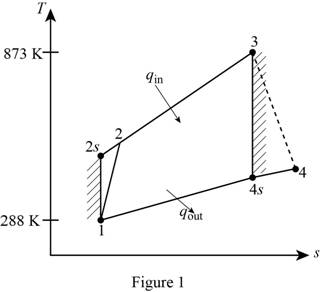
The minimum work that must be supplied to the compressor and turbine due to irreversibilities.
Answer to Problem 143P
The minimum work that must be supplied to the compressor due to irreversibilities is
The minimum work that is developed by the turbine due to irreversibilities is
It can be noted that the compressor is more sensitive to irreversibilities than the turbine.
Explanation of Solution
Show the simple Brayton cycle, with air as the working fluid on

For the given Brayton cycle with air as the working fluid
Write the expression of temperature and pressure relation ratio for the compression process 1-2.
Here, specific heat ratio is k.
Write the expression of efficiency of the compressor
Here, specific heat at constant pressure is
Write the expression of temperature and pressure relation ratio for the expansion process 3-4.
Write the expression of efficiency of the turbine
For compression processes
Write the expression for the entropy change for the isentropic process 1-2s
Here, gas constant of air is R.
Write the expression for reversible work for the isentropic process 1-2s
Here, temperature of the surroundings is
Write the expression for the entropy change for the process 1-2
Write the expression for the reversible work for the process 1-2
Write the expression for the minimum work that must be supplied to the compressor due to irreversibilities
For expansion processes
Write the expression for the entropy change for the isentropic process 3-4s
Write the expression for the reversible work for the isentropic process 3-4s
Write the expression for the entropy change for the process 3-4
Write the expression for the reversible work for the process 3-4
Write the expression for the minimum work that is developed by the turbine due to irreversibilities
Conclusion:
Substitute 288 K for
Rearrange Equation (II), and solve for
Substitute 873 K for
Rearrange Equation (IV), and substitute 873 K for
Substitute
Substitute
Substitute
Substitute
Substitute
Thus, the minimum work that must be supplied to the compressor due to irreversibilities is
Substitute
Substitute
Substitute
Substitute
Substitute
Thus, the minimum work that is developed by the turbine due to irreversibilities is
It can be noted that the compressor is more sensitive to irreversibilities than the turbine.
Want to see more full solutions like this?
Chapter 9 Solutions
Thermodynamics: An Engineering Approach
 Elements Of ElectromagneticsMechanical EngineeringISBN:9780190698614Author:Sadiku, Matthew N. O.Publisher:Oxford University Press
Elements Of ElectromagneticsMechanical EngineeringISBN:9780190698614Author:Sadiku, Matthew N. O.Publisher:Oxford University Press Mechanics of Materials (10th Edition)Mechanical EngineeringISBN:9780134319650Author:Russell C. HibbelerPublisher:PEARSON
Mechanics of Materials (10th Edition)Mechanical EngineeringISBN:9780134319650Author:Russell C. HibbelerPublisher:PEARSON Thermodynamics: An Engineering ApproachMechanical EngineeringISBN:9781259822674Author:Yunus A. Cengel Dr., Michael A. BolesPublisher:McGraw-Hill Education
Thermodynamics: An Engineering ApproachMechanical EngineeringISBN:9781259822674Author:Yunus A. Cengel Dr., Michael A. BolesPublisher:McGraw-Hill Education Control Systems EngineeringMechanical EngineeringISBN:9781118170519Author:Norman S. NisePublisher:WILEY
Control Systems EngineeringMechanical EngineeringISBN:9781118170519Author:Norman S. NisePublisher:WILEY Mechanics of Materials (MindTap Course List)Mechanical EngineeringISBN:9781337093347Author:Barry J. Goodno, James M. GerePublisher:Cengage Learning
Mechanics of Materials (MindTap Course List)Mechanical EngineeringISBN:9781337093347Author:Barry J. Goodno, James M. GerePublisher:Cengage Learning Engineering Mechanics: StaticsMechanical EngineeringISBN:9781118807330Author:James L. Meriam, L. G. Kraige, J. N. BoltonPublisher:WILEY
Engineering Mechanics: StaticsMechanical EngineeringISBN:9781118807330Author:James L. Meriam, L. G. Kraige, J. N. BoltonPublisher:WILEY





